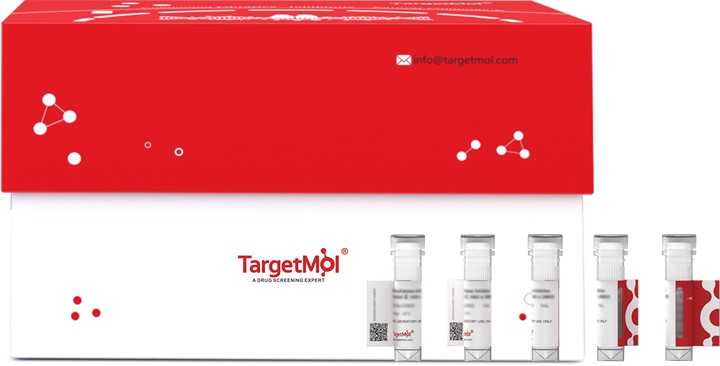- 全部删除
 您的购物车当前为空
您的购物车当前为空
XCL2 Protein, Human, Recombinant (His)
XCL2 is a small cytokine belonging to the XC chemokine family. Chemokines are a group of cytokines. Members of this group of so-called C-Chemokines belong to the SCY family of cytokines and are designated XCL (L for ligand) followed by a number. XCL2 is the new designation of SCM-1-beta. XCL2 is highly related to another chemokine called XCL1. XCL2 gene is located on chromosome 1 in humans. XCL2 is predominantly expressed in activated T cells, but can also be found at low levels in unstimulated cells. XCL2 induces chemotaxis of cells expressing the chemokine receptor XCR1. XCL2 gene has been proposed to participate in pathways (Chemokine signaling pathway, Cytokine-cytokine receptor interaction) and processes (blood circulation, signal transduction, chemotaxis, immune response). XCL2 are expected to have molecular function (chemokine activity) and to localize in various compartments (extracellular space, extracellular region). A putative protein interactor has been described (XCR1). The spliced mRNA putatively encodes a good protein, containing small cytokines (intecrine / chemokine), interleukin-8 like domain; the complete protein appears to be secreted.

XCL2 Protein, Human, Recombinant (His)
| 规格 | 价格 | 库存 | 数量 |
|---|---|---|---|
| 50 μg | ¥ 2,440 | 5日内发货 |
产品信息
| 生物活性 | Activity testing is in progress. It is theoretically active, but we cannot guarantee it. If you require protein activity, we recommend choosing the eukaryotic expression version first. |
| 产品描述 | XCL2 is a small cytokine belonging to the XC chemokine family. Chemokines are a group of cytokines. Members of this group of so-called C-Chemokines belong to the SCY family of cytokines and are designated XCL (L for ligand) followed by a number. XCL2 is the new designation of SCM-1-beta. XCL2 is highly related to another chemokine called XCL1. XCL2 gene is located on chromosome 1 in humans. XCL2 is predominantly expressed in activated T cells, but can also be found at low levels in unstimulated cells. XCL2 induces chemotaxis of cells expressing the chemokine receptor XCR1. XCL2 gene has been proposed to participate in pathways (Chemokine signaling pathway, Cytokine-cytokine receptor interaction) and processes (blood circulation, signal transduction, chemotaxis, immune response). XCL2 are expected to have molecular function (chemokine activity) and to localize in various compartments (extracellular space, extracellular region). A putative protein interactor has been described (XCR1). The spliced mRNA putatively encodes a good protein, containing small cytokines (intecrine / chemokine), interleukin-8 like domain; the complete protein appears to be secreted. |
| 种属 | Human |
| 表达系统 | Baculovirus Insect Cells |
| 标签 | C-His |
| 蛋白编号 | Q9UBD3 |
| 别名 | SCYC2,SCM-1b,SCM1B,hCG_1729916,chemokine (C motif) ligand 2 |
| 蛋白构建 | A DNA sequence encoding the human XCL2 (Q9UBD3) (Met 1-Gly 114) was fused with a polyhistidine tag at the C-terminus. Predicted N terminal: Val 22 |
| 蛋白纯度 | > 90 % as determined by SDS-PAGE |
| 分子量 | 11.7 kDa (predicted); 18-20 kDa (reducing conditions) |
| 内毒素 | < 1.0 EU/μg of the protein as determined by the LAL method. |
| 缓冲液 | Lyophilized from a solution filtered through a 0.22 μm filter, containing 20 mM Tris, 500 mM NaCl, pH 7.4, 10% gly. Typically, a mixture containing 5% to 8% trehalose, mannitol, and 0.01% Tween 80 is incorporated as a protective agent before lyophilization. |
| 复溶方法 | A Certificate of Analysis (CoA) containing reconstitution instructions is included with the products. Please refer to the CoA for detailed information. |
| 存储 | It is recommended to store recombinant proteins at -20°C to -80°C for future use. Lyophilized powders can be stably stored for over 12 months, while liquid products can be stored for 6-12 months at -80°C. For reconstituted protein solutions, the solution can be stored at -20°C to -80°C for at least 3 months. Please avoid multiple freeze-thaw cycles and store products in aliquots. |
| 运输方式 | In general, Lyophilized powders are shipping with blue ice. |
| 研究背景 | XCL2 is a small cytokine belonging to the XC chemokine family. Chemokines are a group of cytokines. Members of this group of so-called C-Chemokines belong to the SCY family of cytokines and are designated XCL (L for ligand) followed by a number. XCL2 is the new designation of SCM-1-beta. XCL2 is highly related to another chemokine called XCL1. XCL2 gene is located on chromosome 1 in humans. XCL2 is predominantly expressed in activated T cells, but can also be found at low levels in unstimulated cells. XCL2 induces chemotaxis of cells expressing the chemokine receptor XCR1. XCL2 gene has been proposed to participate in pathways (Chemokine signaling pathway, Cytokine-cytokine receptor interaction) and processes (blood circulation, signal transduction, chemotaxis, immune response). XCL2 are expected to have molecular function (chemokine activity) and to localize in various compartments (extracellular space, extracellular region). A putative protein interactor has been described (XCR1). The spliced mRNA putatively encodes a good protein, containing small cytokines (intecrine / chemokine), interleukin-8 like domain; the complete protein appears to be secreted. |




